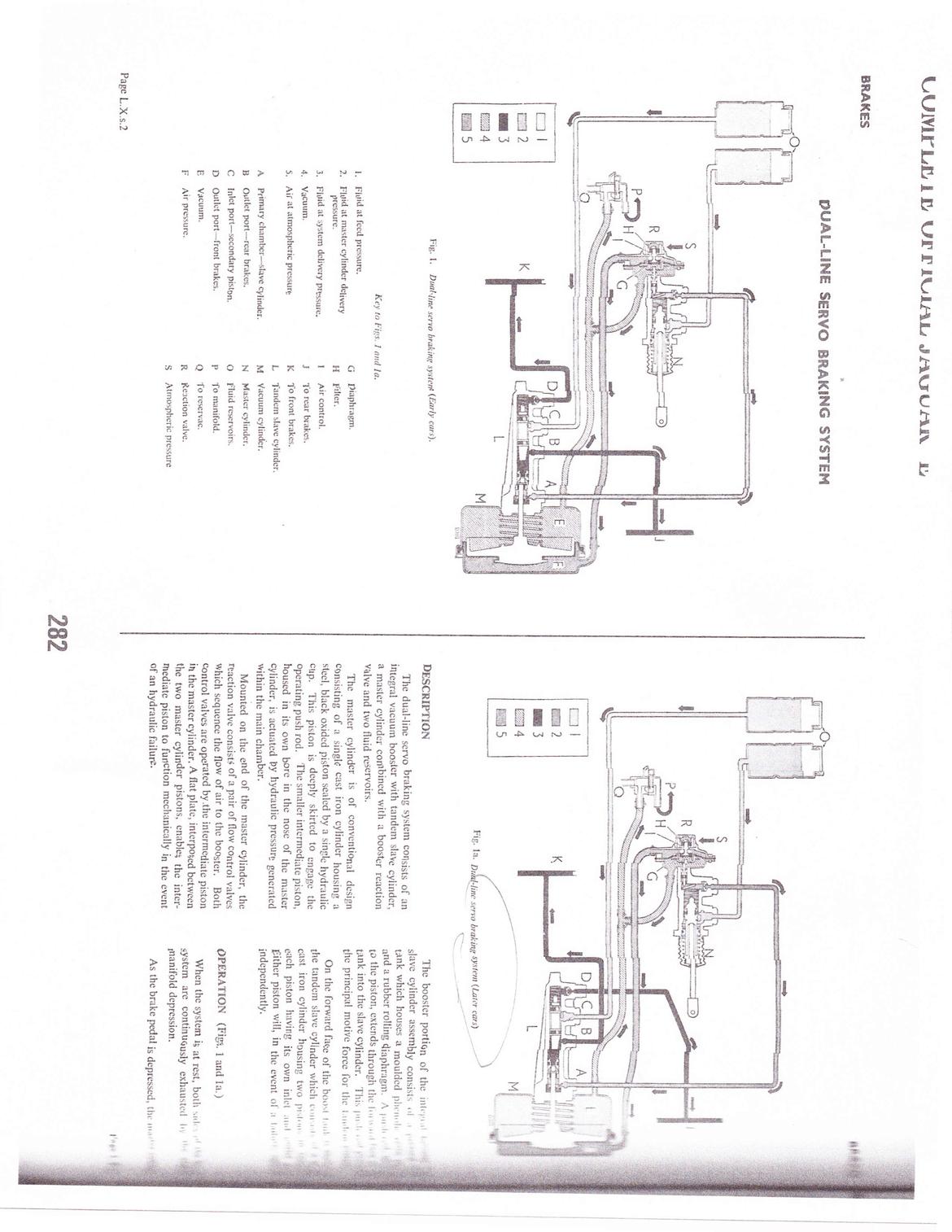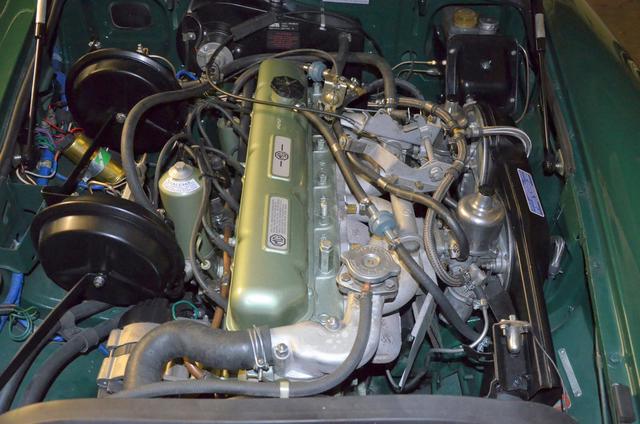
My father has a 1969 Jaguar E-Type and the other day driving around and we noticed a whistle whenever he would brake. We tracked it down to the reaction valve on the end of the master cylinder. He already has the rebuild kit on order, so that is not a concern. But while looking at the system I was trying to wrap my head around why they made it so complex.
Most cars I have seen have a single master cylinder with a booster. The Jag has a master cylinder that when operated operates a slave directly below it that has the booster attached. There are two reservoirs one that feeds the master and one that feeds the slave. When the slave operates it sends the fluid to the brake calipers like most cars. It also has the "reaction valve" on the end of the master cylinder that "consists of a pair of flow control valves which sequence the flow of air to the booster."
Looking at the car, the only reason I can come up with is packaging. They couldnt fit the booster size they wanted in the space they had around the master cylinder so they had to come up with this master / slave / caliper solution.
Anybody have any other thoughts on why they would have done this? sample picture from the web, not my dads car. YOu can see the reservoirs and MC on the right and a little bit of hte booster on the slave directly below.


Sounds like a remote booster. Some American cars had those in the 50s.
There was a thread about them here, brainstorming the ability to use them to make power clutch hydraulics. (Short answer: It "works" but the clutch action is not good)
SanFord had two masters. One on the pedal, and another that was actuated by the first and a vacuum booster. It was the stupidest system I have ever seen.
I ripped it all out and installed a standard booster and a master from a Corvette.

ShawnG
UltimaDork
4/13/21 8:22 p.m.
It's a remote booster. Used because power brakes were an afterthought.
You should see some of the Goldbergian engineering used to hide power brakes in hotrods.
Because they're British and without the extra parts it might not leak enough fluids to be a proper British motorcar.

NOHOME
MegaDork
4/14/21 5:58 a.m.
It is a british thing.... Not sure if it was trying to show some kind or engineering superiority or to keep the service department in business, but most Brit cars of the era were assembled from a collection of Rube Goldberg machines.
The throttle linkage on a Healey 100-4 has over 75 individual parts if you break it down. When it comes to stupid brake systems, hard to beat the MGC with not one, but TWO, remote boosters. Sadly, a lot of MGCs got scrapped because the boosters became NLA and cars were cannibalized for the brake parts and scrapped.

In reply to FieroReinke :
Remember that was a true 150 mph car with 4 wheel disk brakes in 1961 when it was introduced.
When did American cars get disk brakes? 6-7 years later?
You are complaining because the most beautiful car ever made ( according to Enzo Ferrari ) was complex?
Do you also complain if beautiful women are complex?
In reply to NOHOME :
Could be complex because no one had ever done that before?
frenchyd said:
In reply to FieroReinke :
Remember that was a true 150 mph car with 4 wheel disk brakes in 1961 when it was introduced.
When did American cars get disk brakes? 6-7 years later?
You are complaining because the most beautiful car ever made ( according to Enzo Ferrari ) was complex?
Do you also complain if beautiful women are complex?
No we beat the damn British by 12 years. Fact check powered by Stampie.
The first mass produced modern automotive disc brake was in 1949 and 1950, on several models of Crosley cars. Caliper type disc brakes were on all four wheels.
You should check out the Lotus Europa TC layout with power brakes, master cylinder up front, and twin boosters in the engine bay, with both boosters feeding into a PDWA (pressure differential warning actuator) valve right under them. If that's not a recipe for a leak, I don't know what is. A lot of them get converted back to non-power brakes for some reason.

NOHOME
MegaDork
4/14/21 10:01 a.m.
frenchyd said:
In reply to NOHOME :
Could be complex because no one had ever done that before?
To me complex equals poor engineering. Whole point of design is to minimize complexity. BUT, we are all limited by the business model since it drives everything.
I recognize such systems as what I end up with when I am building something in the shop and am limited to using only the bits and parts that are already in the shop cause I got to get it working. The height of British car building coincided with the peak of parts bin engineering. To their credit, there were some beautiful cars built with this business model since style was not a parts bin effort.
frenchyd said:
Do you also complain if beautiful women are complex?
I suppose there are two different kinds of complex: there's the good kind where something has more depth and complexity to it than would appear at first glance. The bad kind is when something has unnecessary parts to do something simple.
The first kind is good in cars and beautiful women. It's why I married my wife and why I think the C5 Corvette chassis is cool (they tuned the chassis so the vibrational nodes are at the drivers seat. That allowed them to give it a stiffer suspension with less sacrifice to ride comfort.).
The second kind of complexity is why 'German Engineering' gets a bad rap and high repair bills and is the source of the saying "no matter how hot she is, somewhere out there is a guy who's sick and tired of putting up with her E36 M3."
Why? because they could. The integrated into the master cylinder unit was not available from the Girling catalog when Jaguar first used disc brakes, which also had an under the floor master cylinder. A few years later when designing the XKE they already had familiarity with the system, and the parts were on the shelf. The dismal reliability and propensity for ingesting brake fluid were just beginning to be apparent too.
In reply to TurnerX19 :
Something tickled my memory... was this the power brake system that got its own chapter in Ralph Nader's book? Something about a certain vintage Buick (when remote power brakes were not uncommon) that would lose power assist/lose brakes because some rubber component in the vacuum portion was not fuel safe...
It's been thirty years since I'd read the book, that is all the detail I can remember.
"Why did Jaguar...?"
The answer to that question is the question!
frenchyd said:
Do you also complain if beautiful women are complex?
I'm certainly hoping the next one is easier to repair.
I'll see myself out...
TurnerX19 said:
Why? because they could. The integrated into the master cylinder unit was not available from the Girling catalog when Jaguar first used disc brakes, which also had an under the floor master cylinder. A few years later when designing the XKE they already had familiarity with the system, and the parts were on the shelf. The dismal reliability and propensity for ingesting brake fluid were just beginning to be apparent too.
The "failure " rate was often due to the use of the wrong brake fluid. Something explained in the owners handbook.
In reply to Pete. (l33t FS) :
I'm just about positive the car Nader was talking about was a was a Buick Roadmaster. GM had a secret recall program where upgraded parts would be installed when the car was in for service for other reasons, but they didn't notify owners otherwise. There was a profile of a guy who died as a result (single circuit brake system, all fluid sucked out, plummeted to his death.)
Edit:
I found a link to the story. https://www.huroncountymuseum.ca/unsafe-in-any-county-the-1953-buick-roadmaster/
I swear there was more to it than that.
In reply to Pete. (l33t FS) :
I burned the book, and choose not to remember it. Does sound like the General though.
In reply to frenchyd :
Damn wrong fluid. Basically, any issue with Jaguar is 'user error'.

ShawnG
UltimaDork
4/15/21 8:08 a.m.
In reply to yupididit :
Haven't you paid any attention to Frenchy?
If something is wrong with your Jaguar, you're simply using it incorrectly.
Most mechanics are monkey see, monkey do trained. ie no formal training. I know most of my knowledge came that way. ( although I have some formal training ).
Nothing wrong with that except it tends to eliminate a lot of knowledge. People think that all engines have pushrods/rocker arms and are confused by other approaches. Making those, "hard"
When Jaguar was developing disk brakes that would stop a car from 150 mph back in 1953 they had to develop their own technology. Rubber that could take 1500 degrees temp, fluids that could deal with the same temps etc.
So yes it was different fluid than drum brakes for Grannies Buick. And different seals etc.

ShawnG
UltimaDork
4/16/21 2:05 p.m.
Umm.. Dunlop built aircraft disc brakes before they built car disc brakes.
I'm pretty sure they had a handle on it before Jaguar started buying their product.
In reply to frenchyd :
I'm curious to know what fluids and rubber they used in the 50s that would take 1500 degree temps. I don't know of a modern brake fluid that can withstand 1500 degrees. Most of them start to boil at 600 degrees or less.
I need some 1500 degree brake fluid for the G35 and my motorhome.
Brake temps are not fluid temps. You can tell brake temps roughly by looking at the color of the brake rotor. The brighter red the higher temps until you get into danger territory with yellow and white.
But Girling Crimson was the high temp fluid of the 50's. And early 60's. Probably nowhere near as good as modern brake fluids.
I used modern fluids on my Black Jack Spl. But I had to flush the old fluid every day. because it absorbs water which causes fluid to boil earlier and earlier.
A track that is brutal on brakes like Road America you need absolutely the best fluid and cooling ducts to finish with any sort of brakes at the end of the race.







































